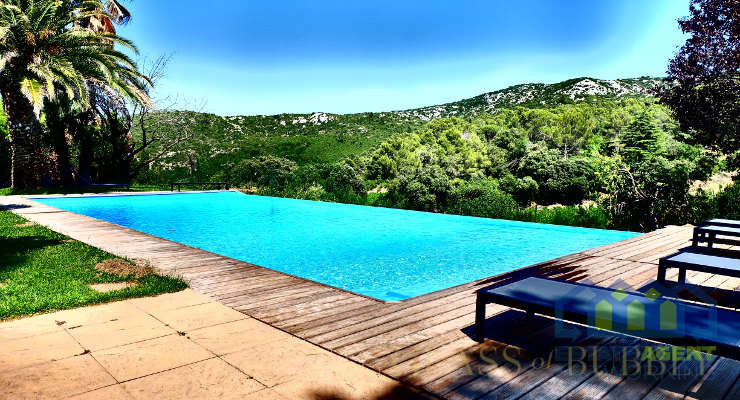3 types of algae and how to prevent it from spoiling your pool
The swimming pool in your garden may be your family’s pride and joy but if algae is forming in the pool water, it will spoil the appearance of the pool and your enjoyment of it. What’s more, while algae in itself isn’t dangerous to humans it can be a breeding ground for bacteria that may be harmful to you and your family.
Prevention is always better than cure, so in order to find out more about this slimy, unsightly topic, I took advice from one of the most respected and experienced pool suppliers, starting with an overview of the types of algae you might encounter.
- Green Algae
The most common type of algae found in swimming pools is green algae, which varies in colour from blue-green to yellow-green or dark green. It can grow and float in water, turning the water a cloudy shade of green, or cling to the walls. Whether you have a thin, slimy film of green algae covering the surface of the pool or floating patches where there’s little water circulation, green algae can spread and multiply quickly.
Left untreated, green algae will overwhelm pool chemicals including chlorine, bromine and biguanide, cause discoloration and staining, clog filters and cause surface damage. Green algae can be treated and removed by aggressive pool shocking and a suitable algicide.
Small-celled green algae (SCGA) is a relative of green algae which leaves the water comparatively clear and is particularly resistant to high levels of chlorine.
- Mustard Algae
Yellow or yellow-orange in colour, mustard algae is a chlorine resistant form of green algae that often resemble dirt or dust on pool floors or walls. Typical places to find mustard algae are shady areas such as behind ladders or under water slides, on vertical faces of shaded stairs – it sticks to everything and it can ‘climb’!
Another characteristic of mustard algae is that it will return to the same location quickly and easily if you simply try to brush it away rather than apply a proper treatment. Slimy, mustard algae are known to survive in high levels of chlorine.
- Black Algae
Black or blue-green algae is the most persistent form of algae, able to survive even the most determined efforts of pool shocking and algaecide treatment. Pool owners will typically notice a high demand for chlorine as one of the tell tale signs of a black algae attack.
It can be identified early as small dots on pool floors and walls that often form in cracks and surface imperfections, particularly in the shade. Black algae will grow in layers to round, coin sized patches with a waxy coating that is tricky to penetrate.
This type of algae is most likely to be found in concrete or plaster finished pools, hardly ever in vinyl liner pools. It produces a heavy, slimy layer while the water remains fairly clear.
How to prevent algae from forming in your pool
Treating an algae problem in your pool will take persistence and specialist advice. However, preventing algae from forming in your pool in the first place is a case of maintaining a healthy, balanced pool water environment. Here are x suggestions:
- Clean your filters regularly
Check your pool filtration system including all the different filters such as a water pump filter, a sand filter and a skimmer basket. Ensure that everything is fully operational and no filter is becoming clogged up. If this happens, the volume of water passing through decreases, which gives algae a greater chance to attach to the surfaces of the pool and filter.
- Monitor the water’s pH balance
Your pool water should always have a pH level of 7.4-7.6 and it’s wise to regularly monitor this level. Of course, on its own this won’t algae from growing (it can tolerate conditions from 6.5-12.5pH), however the correct pool pH will help to maintain an overall balance of your pool chemicals, which is necessary for effective chlorination.
- Brush your pool weekly
Simply brushing of the walls, floors, steps and any other surfaces on a weekly basis is an easy way to break up any possible initial algae formation in your pool. Take particular care when brushing cracks and crevices and any shady areas.
- Monitor your pool chlorine
It’s essential to keep your chlorine levels at 2ppm (part per million) to make sure you have sufficient sanitiser to eliminate any existing algae or minimise any growth between algaecide treatments. Check your chlorine levels every day during the summer months, less frequently at other times of the year, to make sure levels don’t drop.
- Keep fertiliser away from your pool
Lawn fertilisers contain nitrogen, which is a natural algae food. Clearly, if any lawn treatment fertiliser should enter the water, algae growth is almost guaranteed. Never spread lawn fertiliser near an open pool, and check your garden drainage to ensure that any rainwater containing fertiliser runs off safely and not into the pool.
Finally, if it’s too late and algae has already formed, then here are 7 of the Best Pool Algaecides to use In 2020: https://www.globosurfer.com/best-pool-algaecides/









